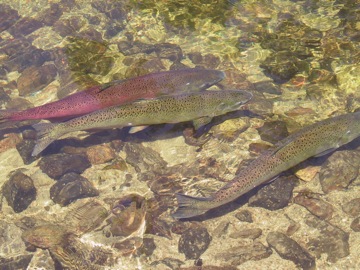U.S. District Court Judge James A. Redden tells Federal Government to come up with backup plan to breach dams.

Judge faults gov’t plan to save Pacific NW salmon
Associated Press
The four dams on the lower Snake River, Lower Granite Dam, Little Goose Dam, Lower Monumental Dam, and Ice Harbor Dam, were originally built for navigation purposes so that Lewiston Idaho could become a sea port. The river provides subsidized transportation for the Palouse region’s wheat and other products but there are other options for them including the existing rail system. The dams don’t generate much in the way of electricity either and when they generate the most, during spring runoff, the demand isn’t at its high as it would be during the heat of the summer when people use it for air conditioning. Because of this the Bonneville Power Administration sells it at very low rates to aluminum smelters on the Columbia River. During the Enron contrived “power crisis” the subsidized electricity was re-sold at a profit by the aluminum smelters instead of letting water pass over the spillways to benefit salmon during the low water year.
The dams disrupt many natural conditions on the river and kill juvenile fish on their downstream migration. Their impact on returning adult salmon is lower but they do cause issues by raising the temperature which diverts a number of Idaho bound late summer, early fall-run steelhead into cooler rivers like the Deschutes River in Oregon.
Several Native American tribes, Idaho, Montana and Washington have engaged in a collaborative process in an attempt at saving the dams but the Spokane and Nez Perce Tribes and are siding with the environmental groups.
Todd True, attorney for the legal group Earthjustice, had this to say about the collaborative process being utilized to come up with a solution.
“Salmon don’t swim in collaboration,” Todd True said. “They won’t return in greater numbers because of a new collaboration — no matter how sincere.”

Comments
It seems to me like dam breaching would be an economic stimulus.
You’d think so, plus more work for the railroads which are desperately in need of funds anyways. The faster those dams are removed the quicker we can move towards real recovery of snake river listed salmon.
Most people don’t realize these dams actually create about 140 miles of continuous slack water. It is remarkable any salmon have survived them. They need to come down.
http://www.wildsalmon.org/pressroom/press-detail.cfm?docid=802
By the way, we won in Utah to preserve stream access!!!
http://www.sltrib.com/outdoors/ci_11871543
jdubya,
Good! Do you want to explain it for us?
Sure. Last summer the Utah supreme court decided, 5-0, that the public had an easement for use of all state waters (rivers and streams) even though they flowed thru private land as long as we stayed within the stream bed. Thus Utahans had basically the same type of access as those in Montana do! Big win.
But this year in the legislature a group of private land owners, the farm bureau and others including the DWR wrote a bill that would have basically kicked us off all but a handful of streams. The anglers and river floaters of Utah united and built a terrific grass roots effort to defeat the bill. The sponsors of the bill started to sweeten the pot by tossing in more rivers and diluting other language but the bill went down to defeat in two different votes in the house. It is now dead for this year, and this summer we need to get to work and write our own bill in anticipation of another fight next year. But for now, a big victory.
FYI, this was written before the first
votes..
http://www.sltrib.com/Opinion/ci_11692395
The fish in the photo look like some kind of trout, not chinook (king) salmon. Anybody know for sure?
They are Chinook salmon. I took the photo myself and worked with Chinook for 8 years at the very location I took the photo.
you worked with chinook for 8 years and can’t even tell a rainbow trout from a chinook ?
It’s better to be a smartass than a dumbass 😉 Admin
Also, those fish were about 30 inches long and I caught fish there that were 42 inches long.
Those are spring chinook salmon near the spawning phase of there life. Looks to be 2 hens and a buck.
Regardless of where you stand on the role of the dams, claiming that they “don’t provide much in the way of electricity,” isn’t very accurate. Each of the dams provides more power than a typical coal plant and together they provide about 5 percent of the Pacific Northwest’s energy, roughly enough to supply Seattle. They have also become increasingly important to meet peak demands, when a power source that can ramp up rapidly (such as a dam) is especially valuable.
Also, they are turning out to be important in the expansion of wind power. That may sound incongruous, but wind is so unpredictable that grid managers need power sources that can come online quickly to fill the gaps when wind stops blowing. You can do that with coal or gas plants, or with dams — each has costs and benefits. Without that, it becomes very difficult to add more wind to the grid. The Bonneville Power Administration has brought more windpower into the system, faster than any other regional utility, in part because the dams provide that flexibility.
It’s fine to debate the future of the dams, but these tradeoffs should be part of the discussion.
Also, fyi, BPA directly serves only two aluminum smelters and neither one is on the Columbia River.
Michael Milstein
BPA public affairs
More details here on power role of the dams:
http://www.bpa.gov/corporate/pubs/fact_sheets/09fs/Fact_Sheet_-_Power_benefits_of_the_lower_Snake_River_dams.pdf
More details here on wind:
http://www.bpa.gov/corporate/pubs/fact_sheets/08fs/Factsheet-keepingupwithWind-December2008.pdf